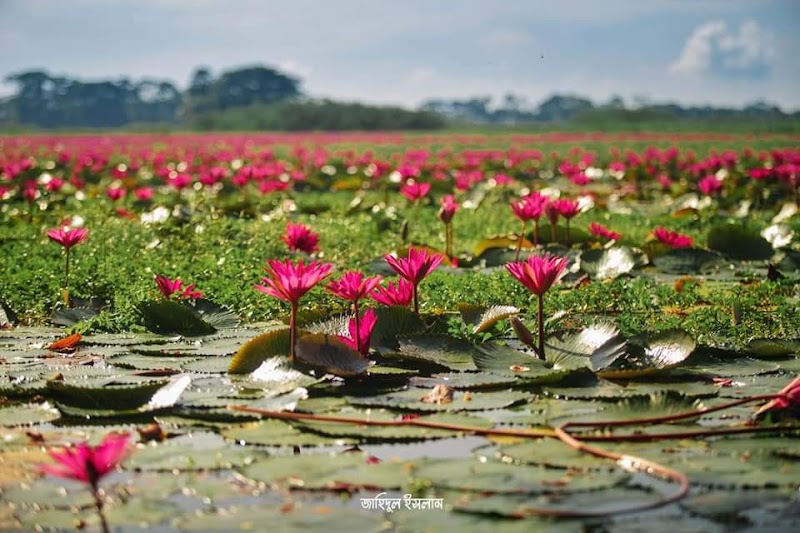
Hook, Line, and Trophy: Local Fishing Tournaments in Gazipur, Dhaka Division
Experience the pulse of Gazipur’s waterways through local fishing tournaments that combine spirited competition with rich community culture. Discover how to prepare for these practical yet exciting events that celebrate the river’s challenging currents and abundant fish life.
Hydrate Strategically
Temperatures rise quickly during tournaments. Carry at least 2 liters of water and drink regularly to maintain focus and energy.
Use Polarized Sunglasses
Reduce surface glare to spot fish activity beneath shifting currents, improving your casting accuracy and bite timing.
Choose Quick-Dry Footwear
Riverbanks can be muddy and slippery. Shoes with good traction and fast drainage keep you stable and comfortable all day.
Arrive Early Morning
Fish are most active at dawn. Early arrival also helps you avoid the midday heat and secures better fishing spots along the banks.
Hook, Line, and Trophy: Local Fishing Tournaments in Gazipur, Dhaka Division
Fishing tournaments in Gazipur bring together local anglers and visitors eager to engage with the waters coursing through this industrious region of the Dhaka Division. These events are practical yet spirited contests held primarily along the rivers connected to the Turag and Balu waterways, which pulse with native species like rohu, catla, and hilsa. The tournaments present not only competitive thrills but a chance to experience the local fishing culture up close.
The fishing grounds primarily stretch over relatively flat, accessible terrain with riverbanks that fluctuate between narrow muddy edges and broader sandy patches. These environments challenge participants with variable currents that can both aid and frustrate efforts, coaxing rods to bend but never fold. The currents dare anglers to adapt their techniques — from casting upstream for a steady bite to countering sudden river surges that push lines forward abruptly.
Competitions usually last several hours on a single day, often early morning through midday, hitting the sweet spot when fish are most active and the air still holds morning humidity before the sun’s full heat asserts itself. Staying hydrated is crucial as temperatures quickly climb above 30°C. Lightweight waterproof gear and layered clothing are wise, with breathable hats and good-quality polarized sunglasses reducing glare and tracking movement beneath the surface. Footwear here needs grip and quick-dry properties for the slippery, sometimes uneven riverbanks.
For those planning to attend or compete, timing matters. The tournaments are often scheduled during the post-monsoon months from October to December and then again briefly in February to March, framing periods when river currents are steady, and fish populations spike before breeding seasons. Organizers typically set entry requirements to maintain sustainable fishing practices, emphasizing catch and release methods to protect fish stocks and river health.
Beyond the thrill of competition, these events highlight local traditions—vendors selling fresh snacks, elders sharing fishing stories by the banks, children cheering every big catch. Gazipur’s fishing tournaments weave together nature and community in a way that respects the river’s fierce character while inviting engagement. Anglers come seeking trophies but leave with a deeper respect for a waterway that remains stubbornly alive and defiantly itself.
Nearby Trips
All Adventures
Boat Charters
Water Activities
Adventures near Gazipur, Dhaka Division
Discover the unique and memorable adventures that make Gazipur, Dhaka Division special.
Frequently Asked Questions
When are the main fishing tournaments held in Gazipur?
Most fishing tournaments take place during the post-monsoon months, specifically October to December and again in February to March, when river currents stabilize and fish populations increase.
Are non-locals allowed to participate in these tournaments?
Yes, many tournaments welcome visiting anglers, but entrants must register in advance and follow local fishing regulations focused on sustainable practices.
What species are commonly caught during these events?
Rohu, catla, and hilsa are the predominant species targeted, prized both for their size and culinary value in local communities.
Is fishing equipment provided or should participants bring their own?
Participants usually bring their own rods and gear. Basic bait and tackle shops can be found near tournament sites for last-minute needs.
Are there any safety concerns along the riverbanks?
Riverbanks can be slippery and uneven; proper footwear is essential. Sudden currents can alter water levels quickly, so staying alert is critical.
Can spectators watch and enjoy the tournaments?
Absolutely. Spectators can join the riverside audience, enjoy local food stalls, and soak in the community atmosphere supporting the anglers.
Recommended Gear
Polarized Sunglasses
Key for cutting river glare and spotting fish beneath moving waters.
Quick-Dry Water Shoes
Protect feet from slippery, uneven riverbanks while draining water fast.
Lightweight Breathable Hat
Shields from sun and helps keep you cool during mid-morning peak heat.
Reusable Water Bottle (minimum 2L)
Staying hydrated is critical when the sun intensifies the challenge on riverbanks.
Local Insights
Hidden Gems
- "Small riverine groves along the Turag provide quiet spots to observe local birdlife between casts."
- "A lesser-known sandy bank near Tongi Bridge offers expansive views and prime fishing spots away from crowded areas."
Wildlife
- "Kingfishers dart like flashes of blue light above the water."
- "Freshwater turtles bask on sun-warmed rocks, indifferent to angler activity."
- "Occasional sightings of fishing cats prowling quietly along riverbanks."
History
"Gazipur’s fishing culture traces back generations, historically linked to subsistence living and now evolving as a community sport and social event."
